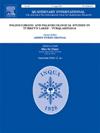Late Holocene seismic uplift events depicted by coastal karst formations in Bali, Indonesia
IF 1.9
3区 地球科学
Q3 GEOGRAPHY, PHYSICAL
引用次数: 0
Abstract
Limestone shores record earthquake-related uplift and subsidence worldwide. While comprehensive investigations exist for the Mediterranean and Japan, only limited studies are available in other regions. In this study, we analyze the carbonate shore of the Sunda Arc on Bali Island, Indonesia, in terms of tectonic uplift/subsidence. We surveyed coastal profiles of terraces and notches, identifying coastal karst features and bioerosion traces and determining their position relative to sea level. We found a set of marine terraces at Suluban Beach: Level A (lowest) – the active reef pavement with occasional surf potholes; Level B – 0.5–0.7 m above level A, with surf potholes and channels; Level C – 0.8 m above level B, heavily pitted by flat-bottomed pans, separated by heavily karstified ridges; Level D – 2 m above level C, karstified surface, with several decimetres deep karren. The increasing depth of coastal karst features marks a longer time of exposure to the sea, both in the intertidal and the supratidal zone. Holocene sea level reached its present-day position about 5000–6000 years ago; therefore, all coastal features, which require the action of the sea, salt water, and wave action to develop, formed following this period. Bali is on the front of the overriding plate in the Sunda arc. Seismicity is expressed by the uplift of the coastal zone. We propose that seismic events of moment magnitude 6.5–7, with a few hundred years return period, can produce the observed repeated surface uplift of 0.5–2 m in Bali.
印度尼西亚巴厘岛海岸喀斯特构造描述的晚全新世地震隆起事件
石灰岩海岸记录了世界范围内与地震有关的隆起和下沉。虽然对地中海和日本进行了全面的调查,但对其他区域的研究却很有限。本文对印度尼西亚巴厘岛巽他弧碳酸盐海岸进行了构造隆升/沉降分析。我们调查了阶地和缺口的海岸剖面,识别了海岸喀斯特特征和生物侵蚀痕迹,并确定了它们相对于海平面的位置。我们在Suluban海滩发现了一组海洋梯田:a级(最低)——活跃的礁石路面偶尔有冲浪坑;B级-高于A级0.5-0.7米,有冲浪坑和通道;C层-高于B层0.8米,被平底平底锅严重坑化,被严重岩溶的山脊隔开;D层- C层以上2米,表面岩溶,有几厘米深的卡伦。无论是潮间带还是潮上带,沿海喀斯特特征的深度增加都标志着其暴露于海面的时间延长。全新世海平面大约在5000-6000年前达到现在的位置;因此,在这一时期之后,形成了所有需要海洋、咸水和波浪作用来发展的海岸特征。巴厘岛位于巽他弧上覆板块的前部。地震活动性表现为海岸带的隆起。我们认为6.5 ~ 7级矩的地震事件可以在巴厘岛产生观测到的0.5 ~ 2 m的重复地表隆起,并且具有几百年的返回周期。
本文章由计算机程序翻译,如有差异,请以英文原文为准。
求助全文
约1分钟内获得全文
求助全文
来源期刊

Quaternary International
地学-地球科学综合
CiteScore
5.60
自引率
4.50%
发文量
336
审稿时长
3 months
期刊介绍:
Quaternary International is the official journal of the International Union for Quaternary Research. The objectives are to publish a high quality scientific journal under the auspices of the premier Quaternary association that reflects the interdisciplinary nature of INQUA and records recent advances in Quaternary science that appeal to a wide audience.
This series will encompass all the full spectrum of the physical and natural sciences that are commonly employed in solving Quaternary problems. The policy is to publish peer refereed collected research papers from symposia, workshops and meetings sponsored by INQUA. In addition, other organizations may request publication of their collected works pertaining to the Quaternary.
 求助内容:
求助内容: 应助结果提醒方式:
应助结果提醒方式:


